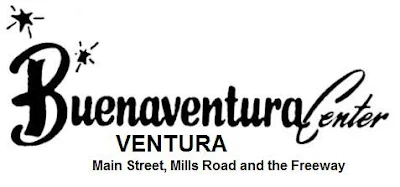
Connecticut's first post-war shopping plaza was built to alleviate traffic in the Lock City's downtown area. The complex featured one of the nation's first shopping center-format Sears stores.
Graphic from Alphons Bach Associates
Welcome to the largest mall and retail history site on the internet. The MALL HALL OF FAME is a vintage shopping mall scrapbook. Its focus is on shopping complexes built -in the USA- between 1946 and 1979. This site includes historical sections about regional department stores, discount stores, 5 & 10 stores and supermarkets. Don't forget to visit our four Shopping Mall Memory Lanes, which transport you through time to a mall in 1956, 1963, 1970 and 1977!


A circa-1975 logo, which includes mention of the RIDGEWAY CENTER "Forty Boutiques" indoor shopping arcade.
Graphic from Ridgeway Center Associates
RIDGEWAY CENTER TENANTS 1975:
SEARS / GIMBELS / FORTY BOUTIQUES (indoor mini-mall) / GRAND CENTRAL MARKET grocery / Barry's Shoes / Better Nature Health Foods / Bread Trader / Consumers Distributing / Datemaker / Discount Records / East Winds Restaurant / Frame Art / George's Art Treasures / Gingham's Dog & Calico Cat / Hand Crafted Novelties / House of Cameras / Jay's Slacks / Lafayette Radio / Leisure Learning / Martha West / Paper Palace / Pitter Patter Maternity / Red Cross Shoes / Ridgeway Flowers / Ridgeway Theatre / Robert Bruce / Sol's Toys / Thom McAn Shoes / Trim Fashions / Waldenbooks / Young Set
Saks 34th Street, the primary RIDGEWAY anchor store, morphed into a
Gimbles in 1965. This store was shuttered in 1986. Hartford's Sage-Allen
chain assumed the vacant space and opened for business in November 1986.
Advert from Sage-Allen & Company
By the early 1980s, RIDGEWAY CENTER was well past its prime. A remodeling and expansion was first proposed around 1982, but was bitterly contested by local residents. Several years of litigation followed, with plans finally being approved by the city. A refurbished RIDGEWAY debuted in 1998. On this layout, newly-built retail space is indicated in medium gray
A share in the complex was sold to a Connecticut-based company in July 2002. They did further modifications to the south store block, with new tenants signed. A shuttered movie theater was reconfigured as part of an LA Fitness facility. Modell's Sporting Goods moved into upper level space that was once part of a Sears store
RIDGEWAY CENTER
Summer and 6th Streets
Fairfield County (Stamford), Connecticut
Alphons Bach was a multifaceted watercolor artist, architect and industrial designer. Born in Germany in 1904, he migrated to New York City in 1926. In 1932, he established an industrial design firm and soon became recognized for his tubular steel furniture, appliance designs and renovations of retail stores.
Bach relocated to Stamford, Connecticut in 1937. At the end of World War II, he entered the realm of real estate development. A 15-acre site, lying .8 mile north of Stamford's center city, would become the first regional shopping center in Connecticut.
Designed and developed by Bach, the first phase shopping complex opened for business on March 26, 1947. Charles E. Moore (Mayor of Stamford) cut a ceremonial ribbon. Charter RIDGEWAY CENTER tenants included W.J. Sloan Home Furnishings (October 1948), Pennsylvania Drug (May 1949), Deena's, Chizzini and a Slenderella Figure Salon.
UTICA SQUARE
East 21st Street South and South Utica Avenue
Tulsa, Oklahoma
One of the first suburban shopping centers on the Great Plains, Tulsa's UTICA SQUARE was built on 25.6 acres, lying 1.2 miles southeast of the downtown district. The cluster complex was developed by Tom Nix and Dale Carter, of Tulsa, and designed by the McCune & McCune firm.
UTICA SQUARE was formally dedicated on May 22, 1952. An invocation was delivered by Reverend Guy Tetirick. Jack Cheairs, Junior (President of the Utica Square Merchants Association) served as Master of Ceremonies. A speech was given by C.M. Warren (Mayor of Tulsa). Developer Don Nix presented a symbolic set of keys to Mr. Cheairs and a ceremonial ribbon was cut by Mrs. C.M. Warren. The three-day dedication included music by Honey Hudgens & Her Orchestra.


